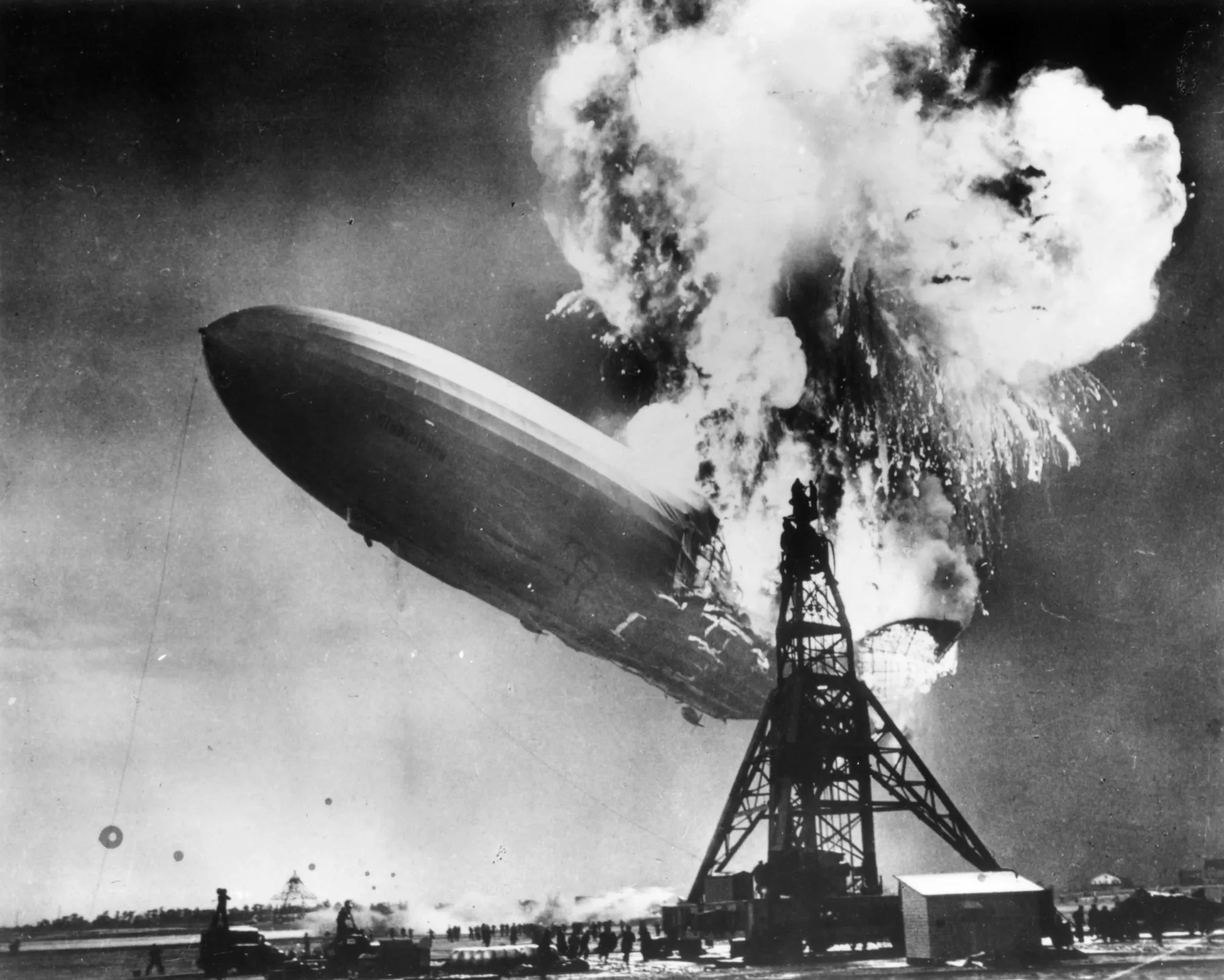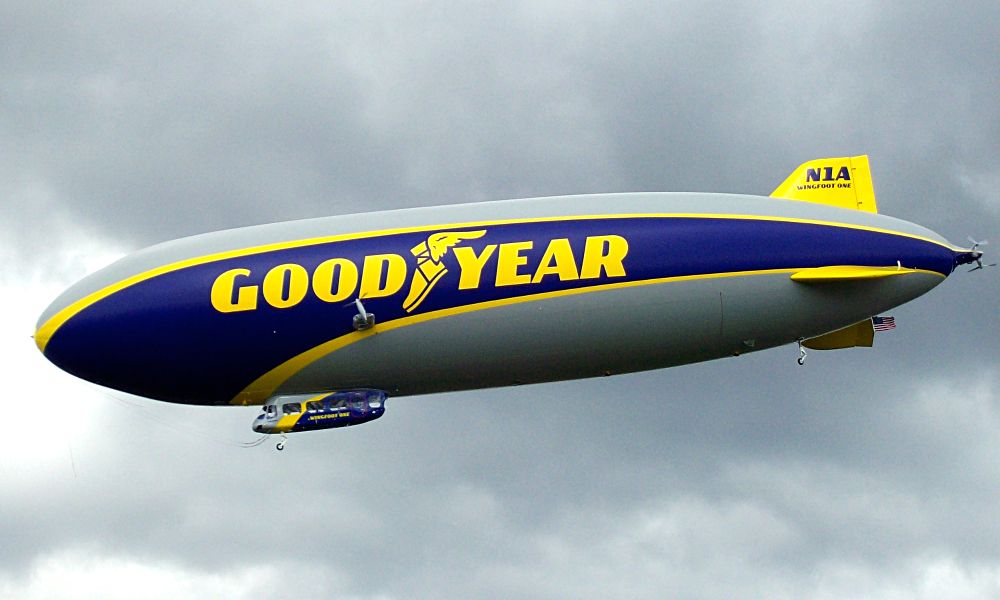Airships

I had a series of dreams once where I was building a flying machine from an old red bus. At the time it felt convincing that I could really make this work - and if I wasn't a pre-teen at the time I would have woken up, started saving and started building.
In fact I still remember the details over 35 years later - red school bus, pot belly stove, water tanks, surprising small pile of firewood to keep things humming along and a crew of primary school peers to run it. The envelope was made of old sheets patched together like a 19th century hobby project and it was no bigger than the roof of the bus.
The stove heated the water, producing steam to fill the envelope. The flying bus could be driven from the driver's seat with normal bus controls, with the addition of a comically oversized lever that controlled movement up and down.
Few things wrong with this idea. My anticipated budget of $300 wouldn't cover all the equipment needed, water is heavy (so is a bus) and a small pile of fire wood wouldn't create enough steam to provide any practical amount of lift. Also an envelope made of patchwork sheets would need to be considerably bigger and air tight to be any use at all.

Anyway that is a long-winded way of saying that I've always considered airships to be the thing of dreams, steampunk and Indiana Jones and not something that really existed as a practical form of transport and may, one day, make a revival.
Real Airships

Early Days
The first recorded invention of an airship comes from 1670 when a priest described a ship that could fly with the use of copper spheres that held a vacuum to provide lift. I'm as surprised as you are to find out that it is theoretically sound, however less surprised to find out you cannot actually make copper balloon with a vacuum inside to lift a ship because it would need to be so thin it would just collapse. Even today it's still beyond what we could actually build with modern materials. But I do like that his airship was an actual ship with a wooden hull and sails.
In 1709 a different priest demonstrated a hot air balloon and in 1784 a not-a-priest attached a hand cranked propeller to a hydrogen balloon to give it propulsion and finally the airship was a reality. Jean-Pierre Blanchard later crossed the English channel in a balloon propelled by flapping wings and had so many adventures he deserves a heading and a photo.
Jean-Pierre and Sophie Blanchard

Jean-Pierre
Jean-Pierre Blanchard flew hydrogen balloons rather than hot air balloons like the more famous Montgolfier brothers. His balloons were propelled by oars or windmills though not entirely successfully at first - where the destination was where you ended up rather than where you intended to end up. Though by 1785 Blanchard had perfected his craft to the point where he was able to make the first successful flight across the English Channel. Louis XVI was so impressed he paid Blanchard a large chunk of cash and ordered the balloon and boat to be displayed in a church I can't pronounce the name of.
Jean-Pierre Blanchard toured Europe being the first to fly in Germany, and Belgium and the Netherlands and Poland. Someone else invented the parachute but Blanchard demonstrated its use by throwing his poor dog out of the balloon on several occasions. One day his balloon split apart, and he had to try out the parachute himself - successfully on this occasion. He even refined the design of the parachute and started making them from folded silk.
Blanchard headed over to America to fly his balloons with one flight witnessed by the president of the time George Washington (you might've heard of him) as well as the future 2nd, 3rd, 4th and 5th presidents (you might not have heard of all of them).
In 1804 he married Sophie who joined him in his ballooning exploits becoming a aeronautical pioneer herself.
After 24 years of ballooning exploits Blanchard had a heart attack and fell out of his balloon - dying from his injuries a year later. His wife, Sophie Blanchard, carried on flying demonstrations up until 1819.
Sofie
Napoleon was a big fan and crowds of people would gather to watch her fly her compact balloon. As she was small and light, she was able to use a smaller balloon which was more portable and could be quickly assembled and launched, or landed and packed up, in order to avoid being mobbed by the adoring crowds. Seems like there were a lot more mobbing crowds in the olden days - or maybe that's just compared to modern pandemic life.
On the 6th of July 1819, with the words "Allons, ce sera pour la dernière fois" ("Let's go, this will be for the last time"), she launched her balloon in windy conditions. She made the poor decision to launch a large number of fireworks in close proximity to a large amount of hydrogen and ended up becoming the first woman ever to die in an aviation accident.
The Blanchards, Montgolfiers and their contemporaries captured the public imagination and sparked 'balloonomaia'. The general public were so excited by all the ballooning going on that they starting wearing balloony clothes, balloony hair styles, and plastered balloon motifs on everything from broaches to snuffboxes to hatpins. All while writing balloon inspired poetry.
There’s something in a flying Horse,
There’s something in a huge balloon:
But through the Clouds I’ll never float
Until I have a little Boat
Shaped like the crescent-moon.
— William Wordsworth
Balloons aren't really airships though so let's get on with it.
Airships (Finally)
Small balloons carrying a single mad-person with only limited control over their direction isn't quite what an airship is all about but these early pioneers, who in many cases paid with their lives, paved the way for the big airships to come.
No doubt you've heard of them referred to as Zeppelins named after Count Ferdinand von Zeppelin who invented large rigid airships in the late 19th and early 20th centuries.

Airships differ from balloons in that they have a rigid envelope full of lifting gas, a long, streamlined shape and can actually propel themselves where they need to go.
Airships are like the James Bond of the sky, while balloons are more like easygoing hippies. You see, airships have a license to thrill with their controlled propulsion and fancy engines, while balloons just go with the flow, man.
(Sorry - ChatGPT wrote the last paragraph with an attempt at humour - I take no responsibility for that.)
In 1900 Zepplin launced the LZ1 the first in the most successful and famous line of airships developed. Blanchard would have been proud that his early experiments led to such large, magnificent ships of the sky. I don't know how he would have felt about their use in World War I though.
War
Airships were used during the war with more psychological rather than military effect - they are very large and relatively easy to shoot down but also hover in the sky, slow and silent and were able to drop bombs. Planes had been invented by now and early airships were no match for the aircraft of the time. Rapid advancements, as tend to happen in war time, produced airships capable of flying at a higher altitude to the aircraft of the day - rendering them immune to attack and even worse at seeing where they were dropping their bombs. In the end, planes were better, faster and more effective and airships were no longer considered an effective military option.
They were still an excellent choice for passenger transport however, considerably faster than a watership - or whatever they are called - a non-stop flight from Germany to New Jersey would take less than 4 days. In relative comfort and luxury.
Assuming you wanted to go to New Jersey for some reason, the alternative in the early 20th Century would have been a train and wetship - or whatever they are called - tediously long journey of 5 or 6 days. Though also in relative comfort and luxury to be honest, or not at all if you were in third class.
An Interlude
Let me take you on a whimsical journey through time to experience the grandeur of a trip on an airship! Picture yourself stepping onto the luxurious deck of an airship, ready for an adventure unlike any other.
As you board, you're greeted by the elegant and spacious interior. Plush seating, reminiscent of a classy parlor, invites you to relax in comfort. The airship's crew, dressed in smart uniforms, offer warm smiles and a sense of excitement as they prepare for takeoff.
Once everyone is settled, the engines hum to life, filling the air with a gentle buzz of anticipation. Slowly, the airship detaches from the mooring and begins its ascent. As you rise higher into the sky, the world below transforms into a breathtaking panorama. You're treated to a mesmerizing bird's-eye view, where rolling landscapes, cityscapes, and rivers stretch out beneath you like a patchwork quilt.
Inside the airship, the atmosphere is serene, with only a soft hum of engines to accompany the gentle sway of the vessel. Large windows offer sweeping vistas, allowing you to drink in the beauty of the world from the comfort of your seat. It's a unique blend of tranquility and adventure, as you float above the clouds, feeling like you're in a dream.
During the journey, the crew attends to your needs with impeccable service. They offer an array of refreshments, from delectable snacks to a delightful selection of beverages. You can savor the flavors while engaging in conversation with fellow passengers, sharing stories and laughter as you make new friends.
Time seems to lose its grip as the airship glides through the sky, gracefully moving from one destination to another. Perhaps you're on a leisurely sightseeing tour, exploring scenic landscapes and iconic landmarks from a magical vantage point. Or maybe you're embarking on a longer voyage, with the airship as your luxurious mode of transportation, whisking you away to far-off lands.
As the journey nears its end, the airship begins its descent, returning you gently to the ground. But the memories of your airship adventure will linger, forever etched in your mind. The experience of floating among the clouds, the breathtaking views, and the camaraderie of fellow passengers create a sense of enchantment that will stay with you long after your feet touch the earth again.
So, my friend, if you ever get the chance to embark on an airship journey, seize it with both hands. It's a whimsical escapade, a blend of elegance and wonder that will transport you to a world where the sky is no longer a limit, but a canvas for unforgettable experiences.
Oh, except you can't because there are no passenger airships anymore. For a number of reasons.

May 6, 1937
Airship accidents were nothing new by the time the Hindenberg caught fire while docking in New York. However, the film footage and narration "Oh the humanity" sent shockwaves around the world.
By the 1930s fixed wing passenger air services were becoming established and the, beautiful, DC-3 aircraft and others were available for faster and more reliable travel than airships were able to provide. In fact, by the time of the Hindenberg disaster Germany was the only country in the world still developing airships - and the 6-year old Empire State Building's airship docking tower had never been used.
In the end, planes were better, faster and more effective and airships were no longer considered an effective passenger option. They were still an excellent option for advertising though, for that one company you might remember.


The future of airships
For the most part interest in airships had died out by the 1940s. But there have been several attempts to get these chubby giants of the sky airborne again.
Despite being slow and enormous, they are still faster than shipping by sea and more environmentally friendly than large jet-powered aircraft. This does, perhaps, provide a niche for shipping things that don't need to move as fast as air freight but faster than a cargo wobblyship - or whatever they are called. They also do not need the same infrastructure that cargo planes, ships, trucks and trains need - allowing access to more remote areas. A good environmentally friendly method of delivering heavy cargo to remote areas could be an electrically propelled airship.
Another option is tourism and luxury travel. Planes suck these days, with cost cutting providing cramped cabins, bad food and uncomfortable seats. They used to be so much better when I was small, and my memories are clouded with the warm embrace of nostalgia. Anyway - assuming one could afford it - airship travel would bring back the luxury of getting from A to B in no particular hurry. No doubt the future of work is more free time and a general slowing down and enjoying the scenery would mesh well with the potential of a revived passenger airship industry.
The least likely option for the future of airships however, sadly, is a bus powered by a pot belly stove, built by a 10-year-old wheezing and lumbering its way through the skies taking classmates on a whimsical adventure.

Photo by Biblioteca Valenciana Nicolau Primitiu / Unsplash
Photo by Levi Stute / Unsplash
